What is this post about?
The list of negative effects of meat consumption is long. They range from animal suffering over global food distribution considerations to climate change and more. In this post, I want to elaborate on the problematic aspects of eating meat and show how it is possible and easy to switch diets without any loss in quality of life. TLDR; please don’t eat meat - it’s really bad for everyone.
1 Reasons against eating animal products
I think most people have heard that animals are held in bad conditions, that meat is less effective than other kinds of food on an energy per gram measure, that meat uses a lot of water during production, etc. However, during most of the discussions I personally had, heard or read about the topic there were astonishingly little numbers and weighings involved. To exaggerate - “you are either a Nazi for eating meat” or “you are a Nazi for taking away someone’s freedom to eat meat” is a discourse that I have witnessed way too often. Therefore I want to focus mostly on the size of the effects w.r.t. a certain topic and explain it in a more understandable manner, i.e. what it means if billions of animals are slaughtered every year or how large the difference of land-use between different diets really is.
1.1 Animal Suffering
I think the most obvious but also most impactful problem with an animal diet is the animal suffering it creates. To give a broad overview of the current state of meat consumption consider the following figures.
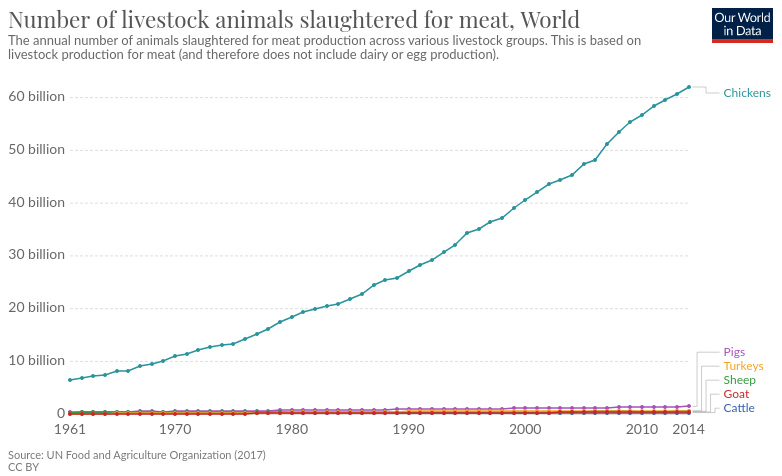
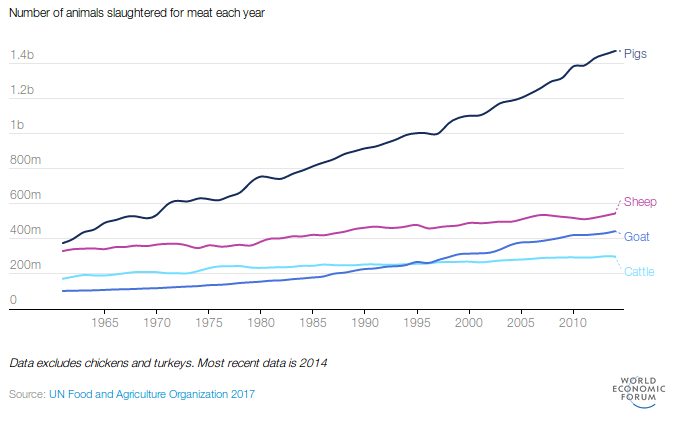
These figures lead to two observations: a) The number of animals killed per year increases pretty drastically, the growth of chickens killed for consumption looks exponential and that for pigs linear. We obviously do not know if that will continue but we do know that consumption has not always been this high. Given that meat is a status symbol in many countries and poverty goes down this is a likely indicator for a still-growing trend. b) The global meat consumption is actually extremely high in objective terms. Assuming that the world has around 7 billion inhabitants this would imply that on average a person eats roughly eight chickens and a fifth of a pig per year. This average gets even bigger when considering that many countries do not consume a lot of meat either due to poverty or religious reasons, e.g. India or many African countries. Looking at the global distribution, richer countries consume more meat than poorer ones. The USA, for example, consumes 8 billion chickens per year which translate to roughly 25 chickens per person and year.
The conditions in which animals are held are horrible in the vast majority of cases (check out mercy for animals for images and further facts). One could consume meat from a more sustainable and fair production but it still comes with all the effects of climate change and inefficient allocation of resources. Additionally, it is not scalable to the same extent as factory farming and therefore many people would have to reduce the amount of meat consumption in any case. However, my main focus is less on exposing these conditions but rather on arguing what they mean in more comprehensive terms. In the Holocaust approximately 17 Million people were murdered. If we think that a chicken has a 16/58000 = 0.00028th of the moral worth of a human this means humanity commits one Holocaust every year on chickens alone. Similarly, in the Rwandan genocide an estimated 1.074 Million atrocities were counted. If we think that a pig has the moral worth of 1.074/14700 = 0.073th of a human, we commit a Rwandan genocide every year on pigs alone. Obviously, these are very rough approximations - these events might be singular in nature, a year in a concentration camp might be very different from one year in a factory farm, etc. However, just comparing these numbers opened my eyes. The number of animals humans kill and eat every year is just incredibly large. Additionally, if someone had asked me about my intuitive estimate of the moral worth of an animal compared to a human before comparing the numbers, I would have given way higher answers for both chickens and pigs. Overall, even if your estimate of the moral worth of an animal is lower or you think I overstate the problematic conditions of animals, we can probably agree that the huge amount of animal suffering created every year is too large.
1.2 Energy Efficiency of Food
To get the same amount of energy, different foods use vastly different amounts of resources. This is also quite plausible - a cow eats a lot of grass or soy during its life. Using soy directly or using the land to grow wheat and make bread or grow vegetables and eat them directly is significantly more efficient than eating the cow after some years of growing. I knew for a long time that there was a difference, I just didn’t know how big it was. Consider the following figures for illustration.
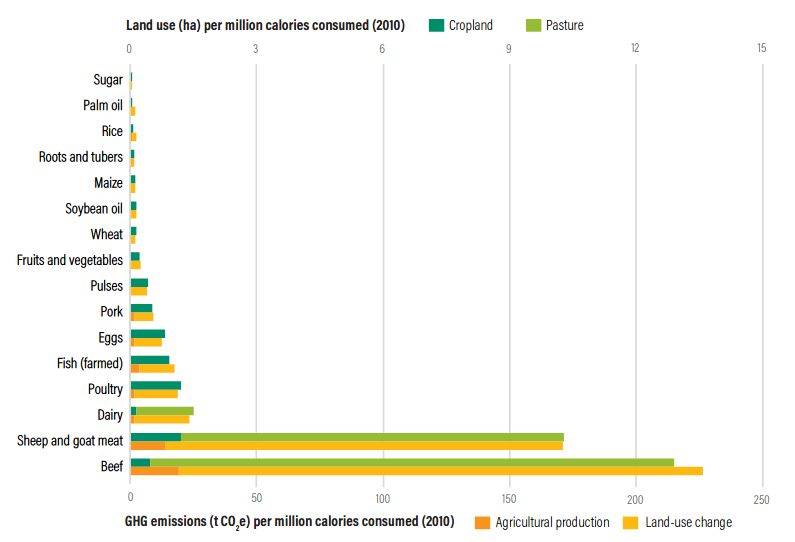
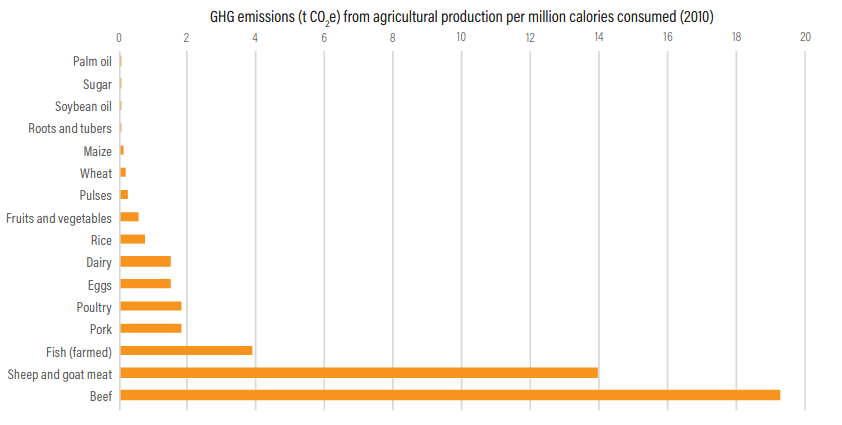
CO2e is the concentration of CO2 that would cause the same level of radiative forcing as a given type and concentration of greenhouse gas. Examples of such greenhouse gases are methane, perfluorocarbons, and nitrous oxide. Of course, calories do not show the entire picture. Palm oil and sugar are super effective but one cannot live by only consuming either of the two. Additionally, proteins are important for a balanced meal and for growth during developmental phases. However, proteins show a similar picture.
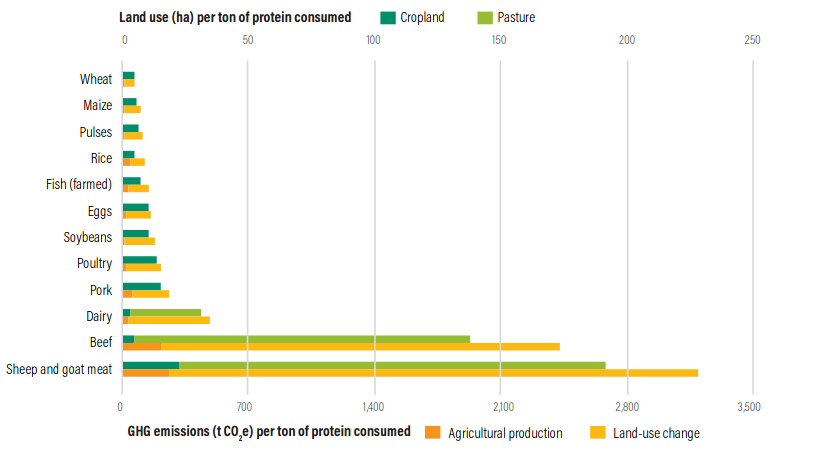
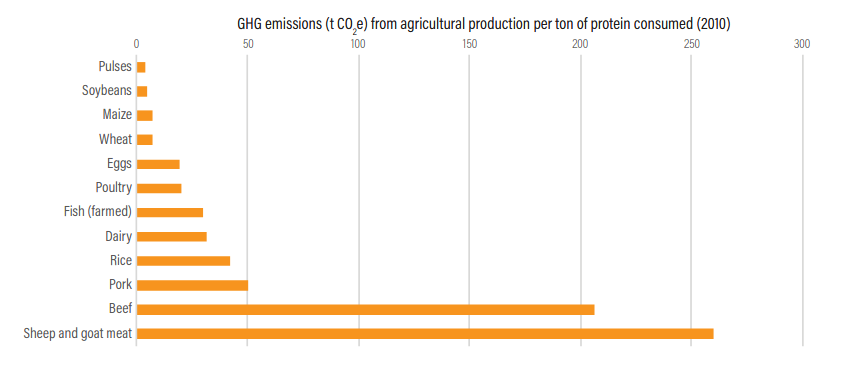
I find the ‘land-use change’ statistic especially worrying in both of the figures. In the World resources report, land-use change is described as: “The GlobAgri-WRR model estimates the GHG emissions from the additional area of agricultural land conversion required to produce each person’s diet. Because land use is increasing, every change in diet that reduces (or increases) land-use demands avoids (or adds) that amount of land conversion.” If I understand correctly, this describes a) conversion of land to farmland such as deforestation of rainforest to farmland and b) repurposing of already existing farmland away from directly usable products like wheat, vegetables, and fruits to animal feed like corn and soy.
Everyone becoming vegetarian would not end world hunger immediately because it is to a large extent an allocation problem, i.e. some countries have too much and others too tittle food but transportation is hard or not economically sustainable. Additionally, some regions are not usable for agriculture but goats or sheep can eat the little bit of vegetation that exists. However, there are lots of reasons to assume that many more people would be able to eat food when less meat would be consumed. a) In developed countries, more of the area could be used for growing food directly instead of animal feed. Even though most developed countries do not suffer a lot of hunger some of the wheat or soy could be exported easily to countries that have worse soil conditions. b) In less developed countries being able to afford meat is often seen as a status symbol and richer people are therefore willing to pay large amounts of money to get it. This means that land is often used for cattle instead of more efficient food and people are starving because of it. However, since it is a status symbol, unfortunately, most people within developing countries are unlikely to change their behavior in the near future. c) Much farmland in the developing world is used to produce animal feed or meat products for the West. In Brazil but also in many African nations corn and soy are produced and shipped to Western factory farms. This literally means people starve because the West uses their farmland to eat more meat. Overall, this will not be able to end world hunger but the Institute on the Environment estimates that 4 billion more people could be fed if everyone switched to a vegetarian diet. Given the expected population growth of 2-3 billion until 2050 this is a possible option in reducing world hunger significantly.
1.3 Climate Change
Food has a large impact on our climate. According to the Intergovernmental Panel on Climate Change’s report “Ca. 25-30% of total GHG emissions are attributable to the food system. These are from agriculture and land use, storage, transport, packaging, processing, retail, and consumption”. The methane which is emitted as a result of the animal’s digestion is accounted for in this estimate. This is a huge amount and cutting it by some percentage would be a large benefit. Considering the following two figures the influence of meat in the average food consumption gets more clear.
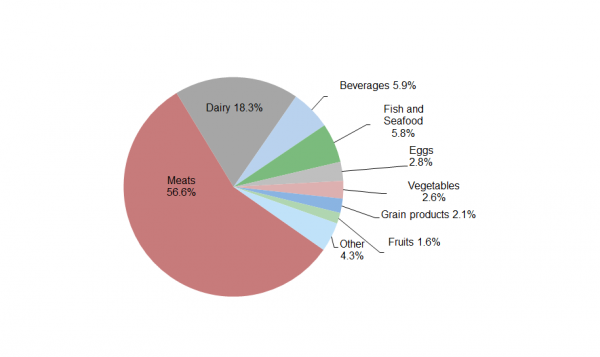
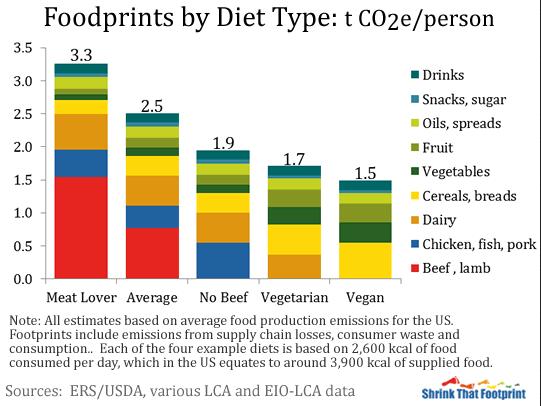
For an average US-citizen, 56% of the GHG emissions related to food consumption come from meat. Another 18% comes from dairy products. However, since the input in energy of meat has to be replaced by other foods we can’t directly translate this to a 56% or 18% reduction in GHG. Considering the average emissions by diet type we can see that fewer animal products lead to lower emissions. Note that someone who would change their diet from eating a lot of meat to vegan would cut their GHG emissions related to food by more than half. A more realistic possibility for most individuals is to either stop eating beef or become vegetarian. As the chart shows this also is a meaningful reduction of around 0.6 to 0.8 tons of CO2e per person and year or in relative terms: a reduction of 24-32 percent. Checking for the location of origin or seasonality of the food also reduces GHG emissions from transportation. However, it is important to state that the biggest part of emissions reduction through a change of diet can simply be done by reducing the proportion of meat in it.
1.4 Multi-Resistant Germs
I think multi-resistant germs are an underrated topic. They are often ignored with a thought of “science and regulation will fix this somehow”. However, there are a large number of worrying trends that do not confirm but rather dispute that exact notion. Let’s consider some facts first: according to this metastudy antibiotic resistance in food animals nearly tripled since 2000. This trend is especially visible in developing countries where rates of multi-resistant germs have increased from 15 to 41 percent in chickens and 13 to 34 percent in pigs. Multi-resistance is measured as the probability of successful treatment through antibiotics of lower than 50%. Just think of this in real terms - you go to a hospital with a simple and easy to treat infection and the doctor tells you: ‘I am sorry, but the probability of our antibiotics working is lower than 50%”. Life and death can literally be a coin toss and people all around the world might start to actually die again due to the most basic infections. The reasons why antibiotics are used to such a large extent in animal food production are simple: a) feeding animals antibiotics in masses make their meat grow faster. b) Feeding antibiotics constantly prevent some of the diseases that the animals would otherwise have. Since antibiotics are currently very cheap it is reasonable for companies to feed them to their animals in large amounts. This means using doses that are 4 or 5 times as high as you would use for humans on a daily basis. As long as this is profitable and not regulated companies are likely to continue with this practice.
multi-resistant germs get to humans. The germs can spread through meat and poultry when animals are slaughtered and processed or they can spread through the animal waste and surrounding environment, i.e. groundwater or soil. This is also why multi-resistant germs are more frequently found in regions around factory farms. So even if you have not witnessed the problem of multi-resistant germs yourself because you, for example, live in a city, just ask a doctor in a more rural area of your country. But even if you live far away from a factory farm the germs are likely to reach you after some time through the meat you eat.
Why can’t they just stop using so many antibiotics? Simply because it is still profitable. But it gets even worse - many farmers use backup antibiotics that should explicitly only be used in emergencies to fight the diseases. Because of the overtreatment the current antibiotics do not work anymore and farmers, therefore, use those that still work. Obviously, this leads to even more resistance over time and making the backup methods useless. We might want the government to just regulate this and prevent it from happening. However, most Western governments are slow to even understand the problem and even slower in finding an adequate solution. Additionally, in most countries, farmers are a strong lobby on politics and therefore make strong regulation significantly harder. Especially in developing countries, this is more problematic since governments often want to increase access to cheap meat because it is seen as a sign of status and wealth. Unfortunately, the free market will also not save us on this one. Major drug manufacturers drop the research of new antibiotics because it is not profitable. The easiest to find antibiotics have already been found and the cost of researching new ones is increasing. Additionally, research finding treatment for different cancers or diabetes is more profitable and therefore has a higher priority for drug manufacturers. Overall, lawmakers are slow, lobbies are strong and the free market can’t make a sufficiently large margin yet. Therefore it is left to us, the consumers, to change the production through either buying meat from more sustainable production or just stop buying it all along.
Do it for the children! The WHO reports that many surgeries will have high risk and people will die from the most basic infections due to a lack of treatment options in the near future. One might think that this is a choice that should be left to each individual to make for themselves and therefore none of my concern. However, those who are impacted the hardest by this are not young healthy men who, on average, consume the most meat. Rather, it hits the elderly, the very young and those who have bad immune systems due to bad luck with their gene pool. Even if you do not care about your own health at least consider the well-being of your little brothers and sisters or grandparents.
1.5 Water Consumption
Producing meat costs a lot of water. Animals drink a lot - a cow, for example, drinks around 60 liters of water per day. Cleaning the animals and the factory farms in which they live uses water. Cleaning the meat from blood and removing leftovers from the floor after slaughtering uses water. This water usage accumulates to huge amounts over time.
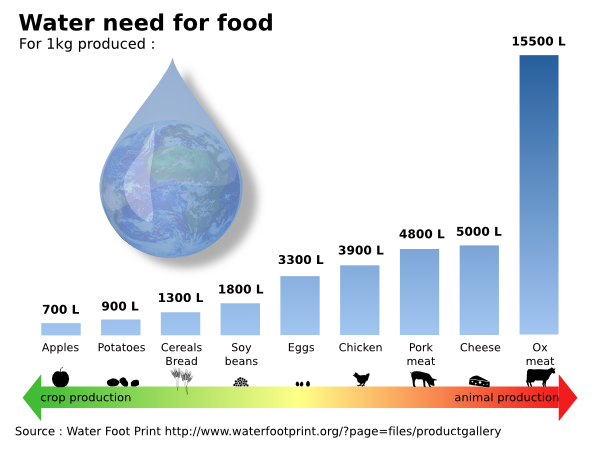
Consider the 15500 liters of water that are used to produce one kilo of beef vs. for example the 900 liters that are used to produce one kilo of potatoes. We might argue that high usage of water is not a problem since most of the water will stay in the region, i.e. all water used for cleaning ends up in the local water supply and can be reused. However, I think there is still harm to this. Water is a finite resource and using it for meat implies not using it for something else. A large chicken farm close to a town might, for example, use up most of the local water reservoir and therefore produce problems during droughts in the summer. This might either mean that ordinary citizens have an insufficient amount of water for their daily life or that other products such as wheat, potatoes or apples are not able to grow properly. Overall, even if I think that this is a problem it is probably less important than the ones mentioned before simply because the meat is often produced in regions with sufficient amounts of water.
1.6 Contamination of Ground Water and Soil
Groundwater contamination from animal agriculture is a problem that mostly arises due to the high number of animals that are concentrated on a very small space because of factory farms. I think this is very intuitive once you think about it. Assume 100.000 cows are held on a small area of land which is equivalent to the size of a small city. All these cows are fed and therefore eat and poop. Their excretion contains lots of nitrogen, partially due to the animals’ digestion but mostly due to the animal feed they receive. Most of the time the defecation is washed into the groundwater with very little filtering efforts. It is because of this that in 2007, 10% of California’s groundwater had a nitrogen level greater than 5 mg/L which is the threshold to count as contaminated. Additionally, the large amounts of soy, corn, etc. needed to feed animals necessitates the use of fertilizer. Many fertilizers contaminate the groundwater or make the soil less nutritious in the long term. This problem is obviously not restricted to meat production but also true for other food. However, the fact that meat is so inefficient in terms of land-use compared to other foods the necessity for more production increases significantly.
2 How to effectively change your diet?
Most of the time when I present any of the above arguments to someone who is currently eating meat I get one of the following responses: “I know it is bad but I just like the taste so much that I don’t care about the rest”, “I should eat less meat but it is just so ingrained in my family and friends group that I cannot change their habits” or “I agree with everything and I will start eating less meat next year” (which then does not happen), etc. - just to show some possible answers. Even though these might seem like unreasonable responses to some, I think all of them have one of multiple underlying reasons that I want to address in the following. These reasons might be irrational fears, the person might be biased in some way or just lack some information. However, independent of the validity of the source of their current reasoning, effective change can only happen if this particular reason is addressed. Acknowledging the problem is often the easy part when compared to an actual change of actions. Breaking bad habits, norms or acknowledging past mistakes is often the hardest part.
2.1 Is there a Case against Meat?
I think the first step has to be a form of moral questioning. Basically, ask yourself whether one of the above arguments - or any other argument against eating meat - is sound. This question is best asked in a vacuum, i.e. without consideration of political motives (e.g. party alignment), possible drawbacks (e.g. no steaks) or social repercussions (e.g. loss of masculinity), this means asking whether any of the above reasons lead to a worse world generally speaking. Even though it is often hard to take this bird’s eye view, it was necessary for me to change my behavior. I learned about the effects of meat on climate change and multi-resistant germs in school and still ate meat every day. I knew the facts but brushed them off and justified eating meat with a high intake of calories for my triathlon training. When my sister became vegetarian and therefore dinner was served without meat I even saw this as a personal attack on me. I was angry with my sister because “she denied me the possibility to be as good as possible in triathlon”. Only when I was forced to take the bird’s eye view on the issue because a friend asked me if I would design an optimal society with omnivores or vegetarians/vegans that I saw that my convictions do not align with my actions and I had to change the latter. I needed to remove myself and my emotional attachments from the equation and ask: “Is there a case against meat”?
2.2 What are the reasons currently holding me back?
The next step for behavior change is to examine the underlying reasons for eating animal products. First and foremost, most people eat meat, yogurt, etc. because of its taste. In the last couple of years, however, plant-based products have become so good of a replacement that they start to pass blind comparisons. Soy or wheat-based burgers taste extremely good and almond or wheat milk is even more durable than cow milk while tasting slightly different but similarly good. The second reason I often face is a kind of habit or lack of inertia, i.e. people do not change diets because “it is too much of a hassle” or people literally do not know what to eat as a vegetarian because they assume we eat the same dish just without the meat (e.g. instead of fish with potatoes we just eat potatoes without anything else). If you hold this or similar beliefs I suggest just google ‘insert your favorite meal here’ + ‘vegetarian’ and you will find a surprising amount of vegetarian variations of your favorite meal. Lastly, we need to talk about social norms - a reason that I think is often underestimated when it comes to eating meat. An image that is particularly present for men and reinforced through media and pop culture is the image of the ‘strong man’. A ‘strong man’ eats meat because it helps with muscle growth, it is healthy and it is ‘what our ancestors’ ate. When someone who lives in a community where this image is particularly strong decides to eat less meat or even stop doing so they become ‘weak men’ in the eyes of the community very quickly. The social repercussions, the loss of status for such men is way higher than I had originally thought and it is really hard to pull off. However, the number of vegetarians is growing and the trend becomes more popular at a fast pace. Therefore the number of people who are vegetarian and who come in contact with the members of that community is growing. Thus I think this norm will probably become weaker over time, even though it is a hard battle for these individuals to fight. Even though I already hinted at some of the possible steps of action, the emphasis in this paragraph lies in identifying the underlying reasons for one’s current behavior. Even if the reasons are not part of the three I just presented there are likely ways to tackle them.
2.3 What can I do to change my behavior?
It is easy to say that one should or want to change behavior but it is hard to actually do so. Otherwise, I would never procrastinate or watch random Youtube videos for an hour and feel bad afterward. Similar to behaviour changes with respect to addiction or bad habits (i.e. drug addiction, bad habits) I would recommend also changing your environment and surroundings and not only rely on willpower alone. This could include steps like writing a list of ingredients to buy for the week before going to the supermarket. If you decide at home that this week will be meatless it is far easier to resist the urge to change that decision in the supermarket. It could also mean telling your friends, family members and other people you frequently eat with to remind you of your original reasons not to eat meat when thinking about eating meat again. By doing so you have to face an external barrier when you start to rationalize internal decisions. The last suggestion is nudging yourself in your own decision making by restricting possible options. That could either be choosing fully vegetarian/vegan restaurants when going out or only looking at the vegetarian part of a menu to prevent short term decisions that you later regret. However, as a basic mechanism to make all the other changes easier, I think it is important to regularly reflect and evaluate on one’s current strategies and goals w.r.t. meat consumption. For example, one could check every month roughly how high the number of meatless days was and ask whether this number is sufficiently low and fits into the grander strategy of e.g. becoming vegetarian in half a year.
2.4 What are the trade-offs that I am willing to make?
A change of behavior does not have to manifest in the adoption of veganism from one day to another. Cutting back meat consumption in half is already a 50% reduction in animal suffering and some reduction of carbon emissions. The reduction in consumption also does not have to be from one day to the next as long as one follows an overall strategy of reduction and is willing to do small steps and gets used to the new situation. Overall, I think it is not necessary to optimize one’s food choice to the maximum i.e. eat vegan all the time. As we have established in the first part, the biggest harms of food are linked to the amount of meat one consumes, i.e. the suffering, the CO2e emissions, the contaminations, etc. are mostly due to meat consumption. That means if someone cuts this part of their diet to only eating meat once a week they have done the largest amount of the possible reduction already. Obviously, more reduction is always better but in my opinion, there are reasonable trade-offs to make. If, for example, you gain a lot of utility by eating cheese from time to time, use cream for some dishes or even eat meat for special occasions, I think this can be a valid decision. The reason why I still try to reduce animal-based food as much as possible are two-fold: a) I generally do not miss meat. Whenever I have the rare urge to eat meat I can use one of the many meat-alternatives that exist out there. Since both the consistency and the taste is very similar there is no strong reason for me to actually kill an animal. b) I am afraid of value drift and a slippery slope, i.e. when I decide to eat meat on special occasions I might lower the standards for what a special occasion means over time without really noticing it. Especially in stressful periods of life, it becomes very easy to ‘treat oneself’ with meat because ‘there is so much other stuff to think about’. However, as long as one is able to prevent this kind of trend from happening I think it’s fine to sometimes make the trade-off in favor of meat.
One last note:
If you have any feedback regarding anything (i.e. layout, code or opinions) please tell me in a constructive manner via your preferred means of communication.